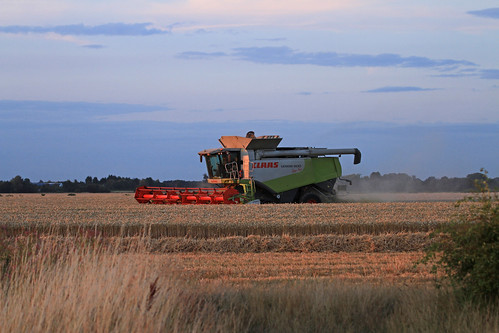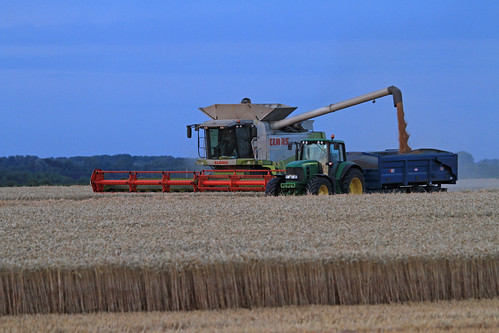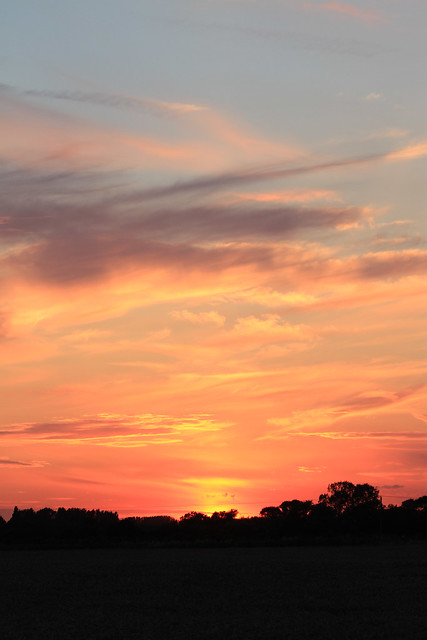All the posts from my home patch have focussed on the wildlife and the impact of humans on the wildlife without much focus on the human activities per se. So as it’s harvest time now, or it would be in a normal year, and the harvest is such an important event in human interaction with the countryside, I want to devote this post to it.
The harvest was nearly all done and dusted by the last week in July here this year, which is a good 2-3 weeks earlier than in a climatically normal year. These pictures are from last year when the bulk of the harvest took place in the second and third weeks of August. The crops vary in my local fields, and wheat, barley and oil seed rape are commonly planted.
 Leviathan of the Fens – the combine harvester – gathering the crop
Leviathan of the Fens – the combine harvester – gathering the crop
Last year it was either wheat or barley so when harvest time began it heralded the arrival of some seriously big machinery. The speed with which these gigantic beasts gathered the grain and separated it from the straw and depatched the produce was breathtaking.
 Dancing a duet with the tractor – it was all perfectly choreographed
Dancing a duet with the tractor – it was all perfectly choreographed
The grain was unloaded into a trailer drawn by a tractor and the straw was jettisoned out the back to be simultaneously baled by a second tractor towing a baling machine :
 And a quick change of partner for a waltz with the baler
And a quick change of partner for a waltz with the baler
The whole operation lasted just a few hours and was done with military precision and at the end all that was left was neatly arranged piles of bales amidst acres of stubble. A few years ago I was talking to a farmer in a pub near Cambridge and he told me that the harvesters have onboard computers which record how much grain is harvested from every part of the individual fields, and where yields drop it is all mapped via GPS so when fertiliser is applied prior to the next sowing operation, more will be applied in the areas of the fields which delivered the lower yields during the previous harvest. And of course, with that degree of efficiency applied to the whole process there is nothing left over for the wildlife as there was in the years pre-agro-intensification, and that’s a major reason why species such as tree sparrow, turtle dove, yellowhammer etc, are struggling. I’ve noticed in these fields that after the harvest nearly all the birdlife including yellowhammer, skylark, corn bunting, linnet and reed bunting all drastically decrease in numbers until the next springtime.
And whilst all that was ongoing there was another baler tidying up an adjacent field which is managed by a different farmer:
These monstrous bales aren’t the type that can be thrown around by a couple of farmhands and manually stacked on a flatbed trailer, they are around my height in diameter and require more big machinery to move them:
Another homeless (and endangered) farmland bird wondering what’s happened to his shelter and his meals:
 A bewildered looking grey partidge (Perdix perdix) forced to the margins after the harvest
A bewildered looking grey partidge (Perdix perdix) forced to the margins after the harvest
And of course, at this time of year, the grain isn’t the only harvest:
 Juicy ripe plums hanging in the hedgerow
Juicy ripe plums hanging in the hedgerow
Another ramification of intensive farming is the destruction of the hedgerows. It’s something we wised up to in this country some years ago, with regard to grubbing them out, but nowadays farmers insist on attacking the ones that remain with flails (if anyone knows why they spend money and time doing this please let me know), including the one where these plums were growing. Not only does this thin the hedge right down so it provides less cover for overwintering birds, rodents, insects etc, the trees and bushes which grow there and provide food for the wildlife are producing less of these gorgeous fruit. So the wildlife is getting squeezed into a smaller and smaller fraction of the countryside and their shelter is under constant attack and their food source is constantly depleted. I think it’s not a good way to manage the countryside.
 At harvest time with all the dust in the air it makes for some glorious sunsets
At harvest time with all the dust in the air it makes for some glorious sunsets
But on the optimistic side, I reckon it is possible for farmland to be managed to produce sufficient food for humans and still sustain our wildlife. I just hope that as a species we wise up before it’s too late. And at the risk of stirring up controversy… maybe we should simply learn not to waste so much.






That brought back memories of living in that part of the world, although in my day combine harvesters were on a smaller scale & straw bales the perfect size for leap-frogging & other games. I don’t get hedge-massacring either- my step-father was a woodsman and used to spend hours ‘laying’ boundary hedges manually. I guess that is too labour-intensive and expensive these days.
Hats off to your stepdad, hedge laying is a wonderful skill and I wish there was more of it. I reckon flailing is just lazy, cheap and pointless – like so much else these days when monetary cost is the sole consideration!
On a lighter note though, it would be fun to try to leapfrog one of those gargantuan hayballs!
With you on the hope Finn…more and more farmers are becoming aware of just how important hedgerows are in encouraging beneficials that protect their crops from the ravages of pest species that see that great big mono crop from space and come flocking…how far can we remove ourselves from nature before nature removes herself from us?
That is THEE pertinent question of our times in my opinion. When nature finally cuts loose and rectifies the situation it won’t be pretty. Can we wise up and head off the worst effects? I don’t know, we’re pushing it to the wire.
😦
Wonderful photos. heartbreaking facts…
Hello Valerie, great to hear from you! I think one reaps what one sows, and if we don’t stop destroying everything soon nature will conduct its own rebalancing operation, and it won’t be good for anyone!
Strange, but I never realised there were such big harvesters in the UK.
This machine seemed to be the size of my house! I guess the bigger they are the more efficient they are.